How we increased conversion: CleanTalk Anti-Spam cloud service history
We want to talk about how we have achieved a higher conversion of the cloud service CleanTalk Anti-Spam , applying fairly simple solutions and evaluating their effectiveness.
CleanTalk Anti-Spam is a cloud spam bots protection service for websites. Since the introduction of the service, the number of customers has steadily increased, but over time it became clear that the conversion efficiency of the site can be increased.
For ease of understanding and analysis, we divided the conversion into “free” (registration on the site) and “paid” (start using paid services of the service). Of course, they are interrelated: by increasing the number of users at the registration stage, we obtain an increase in paid users.
So, we decided that increasing the number of users of the service is within our power, but for this we need to look for options to optimize the existing channels of attraction. As a result, having spent relatively little resources and time searching and testing methods, we achieved very impressive results that surpassed our wildest expectations: conversion in registration increased by about 98%, and registered in paid - by 49.4%.
')
CleanTalk Anti-Spam users are companies that have a corporate website, private personal site owners, webmasters and studios, as well as online store owners. In fact, the need for protection against spam bots may arise from any website that has any form to fill out.
The expectations of users regarding the anti-spam service are quite natural and predictable: once they turn, they want to get everything in order not to pay attention and existing problems of attention and not to waste their time. They want to be completely confident in the effectiveness and fully trust the decision. In our case, this means that they receive protection from spam, which is invisible to visitors and does not force them to take additional actions to prove that they are human.
The first thing that we noticed as a potential source of growth in registrations is the changes in the site design. However, as it turned out in our case, the design has almost no effect on the conversion. We have developed several variants of the external execution of the main page of the site and tested them, but this did not give any tangible result.
The next thing we decided to try is to place the registration button directly on the part of the site that is the main engine of traffic. The solution is quite obvious: interested visitors see the offer in the place of the site for which they came to him. In our case, these are blacklists of IP- and email-addresses from which spam is sent. As a result, a simple call for registration in the right place for two months of testing gave a 6.6% increase in registrations. Of course, after that we left the button in a new place.
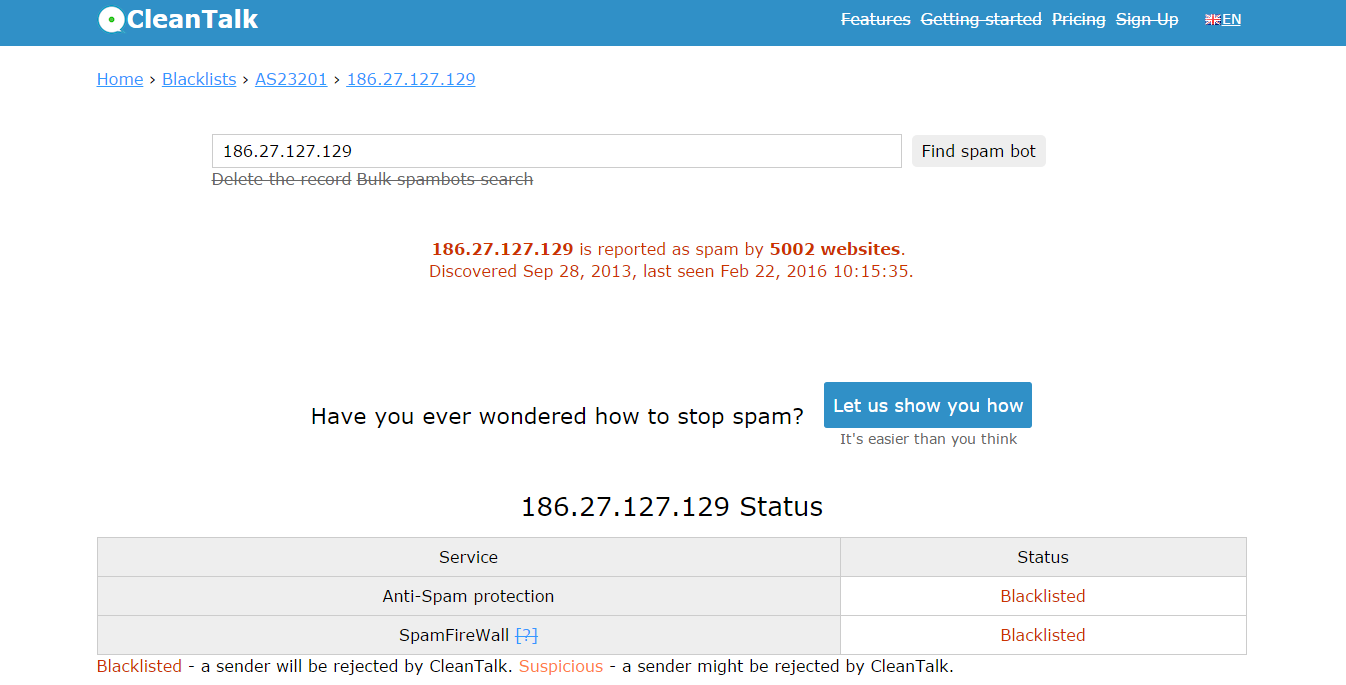
The next step we decided to place a pop-up window with a banner containing a call for registration. This banner is displayed only after the user performs the second search on the site: this is how only targeted visitors see him, most likely in need of protection from spam bots.
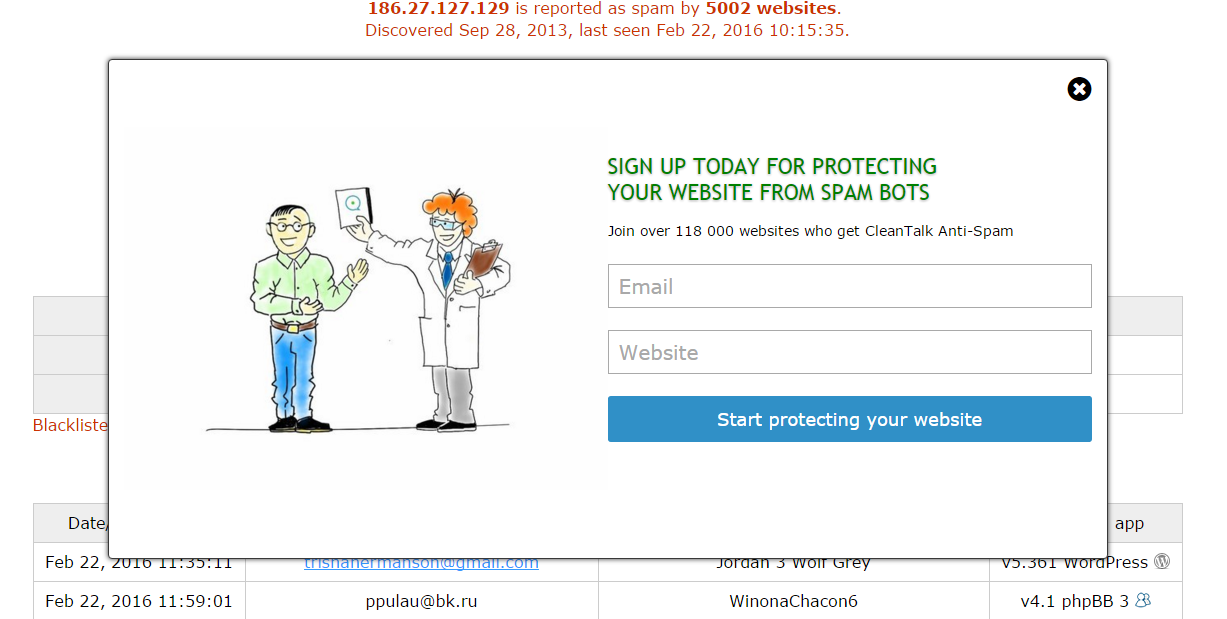
Despite the popular and well-founded opinion that pop-up banners annoy visitors, we received an increase in registrations from the search in black lists by 38.9%. At the same time, we did not receive any complaints and did not see a decrease in repeated visits to the site.
After this, we can give advice: look at what additional data you can use to attract users. Describe in a single phrase which problem you are resolving to the user, and make users an offer with the minimum steps necessary to achieve the goal.
Further study of our own site led to the idea that it is possible to simplify the registration procedure and the form for it. We have removed from the form all the extra fields, leaving only the most necessary. So, now users do not need to invent passwords, they are generated automatically and come immediately after registration to the specified email box along with other necessary information. As a result, only two fields remain in the form - the e-mail address and the site address.
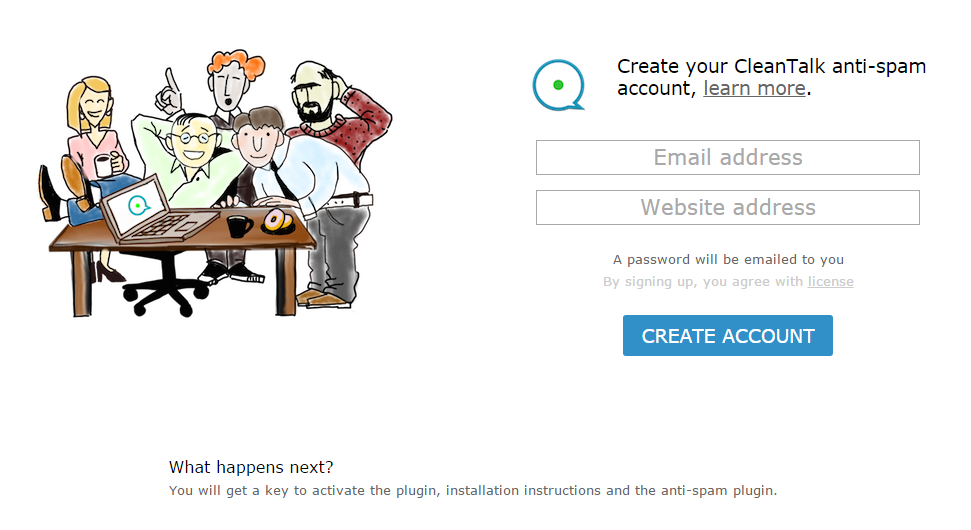
When refusing to manually enter a password in favor of its automatic generation, we were guided by the consideration that a new user, having come to an unfamiliar service, is unlikely to want to use his usual password, but rather will invent a new one. Of course, this complicates his task, the user can leave the site altogether. By simplifying it, we achieved registration growth of about 12%.
A good result was given by embedding the registration form in the plugin settings page for CMS WordPress and Joomla. Due to the simplicity and speed of registration, the conversion increase was 19.5%.
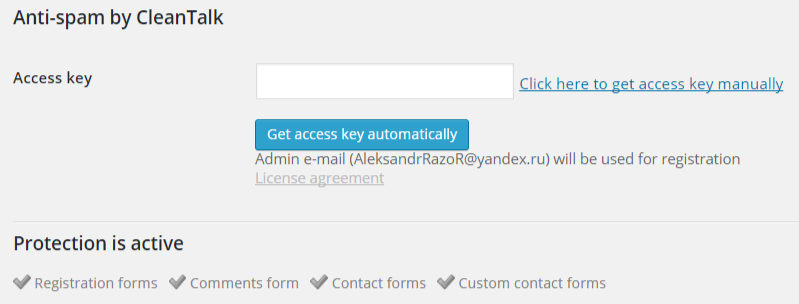
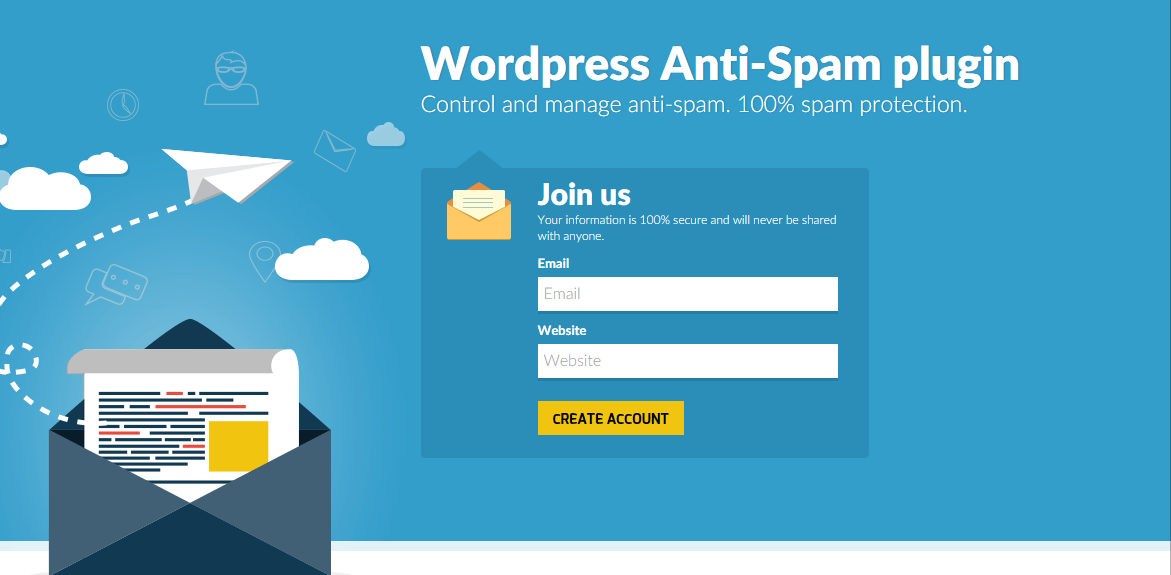
Due to the features of the SaaS model, most cloud services, including CleanTalk Anti-Spam, provide users with a free trial period. True, the length of the period for each service is different, so we decided to find the best option experimentally. Moreover, the duration of the trial period and the conversion also depend on the source of registration.
We assumed that, depending on the source of registration, our users need a different trial period. From some sources, users come prepared and “ripe”, while from others they still need time to explore the possibilities of the service. For CleanTalk, registration sources can be divided into three categories:
We divided the sources and for each of them changed the duration of the study period. It is worth saying that the system does not display the duration of the trial period in days; instead, users see the date up to which they can use the CleanTalk functionality without payment.
For blacklisted search traffic, the best conversion was for a 7-day free period. Compared with the 14-day trial period, which we applied to all users initially, the conversion increased by 86%!
For registrations from plug-in catalogs, the best indicator was 14 days. Selective user survey showed that this group of users needs more time to evaluate the functionality of the service and its applicability in their situation. Due to the fact that we initially used the 14-day free period, other options for its duration caused a decrease in conversion.
But for users who came from websites and social networks, there was no need for an introductory period at all. As we assume, this is due to the fact that these users move from sites where they have already read the service, read the description, review or review. That is, they already have the recommendation of a trusted and authoritative source for them, so there is no need for testing. Thus, compared with the 14-day period, the growth of paid users was 115%.
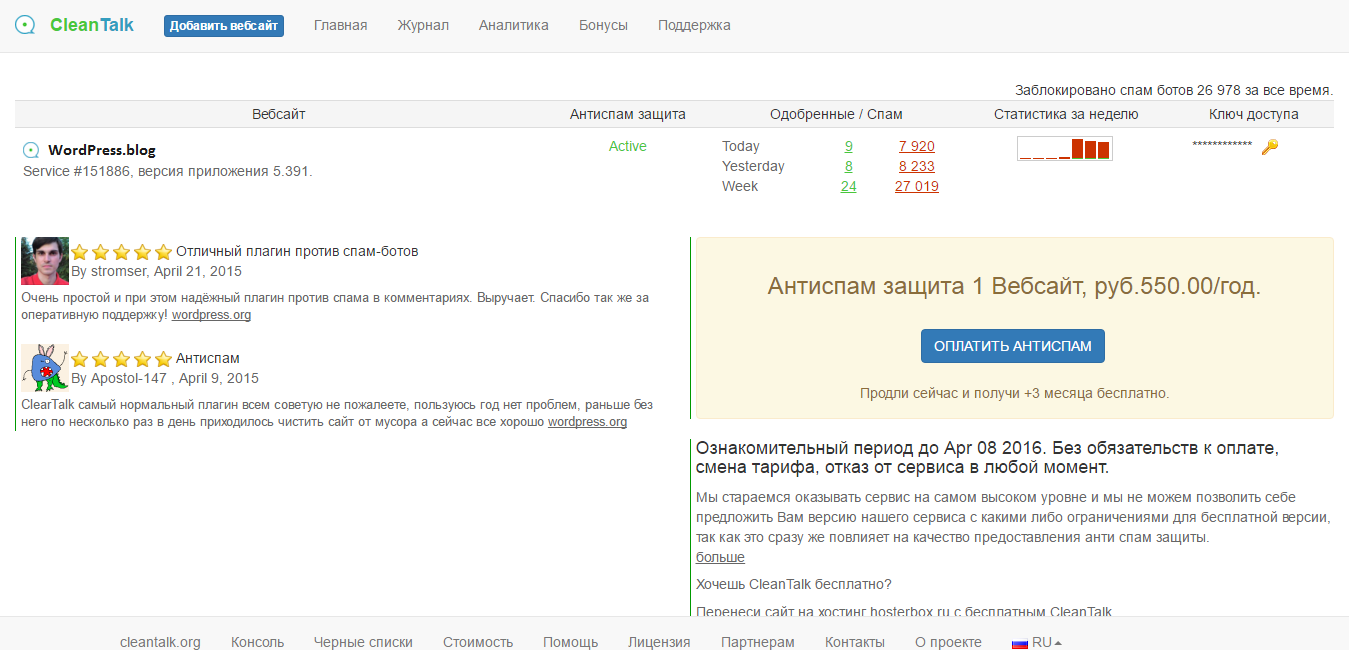
No less attentive is to approach the choice of payment systems and the order of their placement on the payment page. Be sure to choose a proven and well-known payment system, and not lean in favor of those in which the lower commission. Also, do not introduce too many payment methods, as it disperses the attention of users and causes them to doubt the original choice.
Some time ago we experienced certain technical problems with accepting payment through PayPal. As a result, we moved this system down, which turned out to be a mistake. During the test, we left only two methods of payment, and PayPal again raised to the top. As a result, the number of payments increased by 23%.
Placing security certificates on the payment page and EV Green Bar in the address bar on the site should give an increase in user confidence and, as a result, an increase in conversion. True, in our case both of these actions yielded no result. This is probably due to the high level of technical literacy of the service audience, which does not need to be further convinced of the security of popular payment systems.
We continue to use the EV Green Bar, and the security certificate icon has been replaced with a refund guarantee icon. True, he, too, had no effect and serves only to inform users of this possibility.
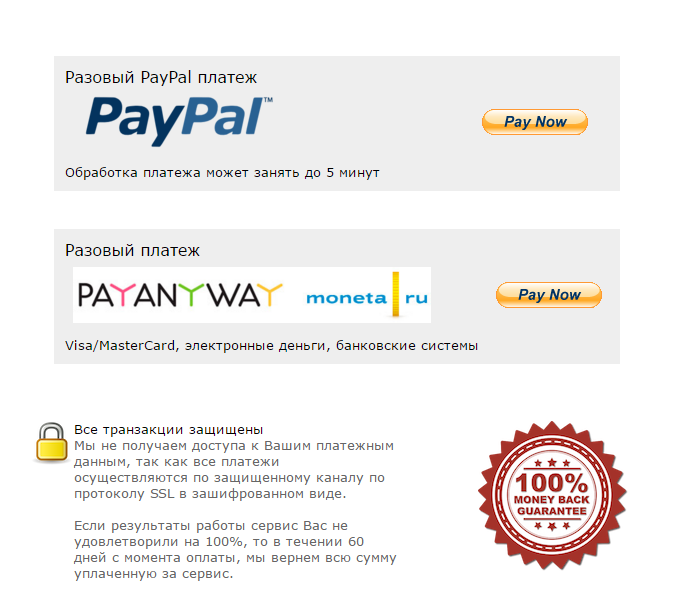
We were very pleased with the results. At the same time, even those actions that did not have the desired effect in our case, in other situations, can bring substantial benefits to the business. For each service, everything is very individual and depends on a variety of parameters. We would like to draw your attention to the things that have helped us in development. Perhaps our experience will be useful to you.
About CleanTalk Service
CleanTalk is a cloud service to protect websites from spambots. CleanTalk uses protection methods that are invisible to website visitors. This allows you to abandon the methods of protection that require the user to prove that he is a person (captcha, question-answer, etc.).
CleanTalk Anti-Spam is a cloud spam bots protection service for websites. Since the introduction of the service, the number of customers has steadily increased, but over time it became clear that the conversion efficiency of the site can be increased.
For ease of understanding and analysis, we divided the conversion into “free” (registration on the site) and “paid” (start using paid services of the service). Of course, they are interrelated: by increasing the number of users at the registration stage, we obtain an increase in paid users.
So, we decided that increasing the number of users of the service is within our power, but for this we need to look for options to optimize the existing channels of attraction. As a result, having spent relatively little resources and time searching and testing methods, we achieved very impressive results that surpassed our wildest expectations: conversion in registration increased by about 98%, and registered in paid - by 49.4%.
')
Our users
CleanTalk Anti-Spam users are companies that have a corporate website, private personal site owners, webmasters and studios, as well as online store owners. In fact, the need for protection against spam bots may arise from any website that has any form to fill out.
The expectations of users regarding the anti-spam service are quite natural and predictable: once they turn, they want to get everything in order not to pay attention and existing problems of attention and not to waste their time. They want to be completely confident in the effectiveness and fully trust the decision. In our case, this means that they receive protection from spam, which is invisible to visitors and does not force them to take additional actions to prove that they are human.
"Free" conversion
The first thing that we noticed as a potential source of growth in registrations is the changes in the site design. However, as it turned out in our case, the design has almost no effect on the conversion. We have developed several variants of the external execution of the main page of the site and tested them, but this did not give any tangible result.
The next thing we decided to try is to place the registration button directly on the part of the site that is the main engine of traffic. The solution is quite obvious: interested visitors see the offer in the place of the site for which they came to him. In our case, these are blacklists of IP- and email-addresses from which spam is sent. As a result, a simple call for registration in the right place for two months of testing gave a 6.6% increase in registrations. Of course, after that we left the button in a new place.

The next step we decided to place a pop-up window with a banner containing a call for registration. This banner is displayed only after the user performs the second search on the site: this is how only targeted visitors see him, most likely in need of protection from spam bots.

Despite the popular and well-founded opinion that pop-up banners annoy visitors, we received an increase in registrations from the search in black lists by 38.9%. At the same time, we did not receive any complaints and did not see a decrease in repeated visits to the site.
After this, we can give advice: look at what additional data you can use to attract users. Describe in a single phrase which problem you are resolving to the user, and make users an offer with the minimum steps necessary to achieve the goal.
Further study of our own site led to the idea that it is possible to simplify the registration procedure and the form for it. We have removed from the form all the extra fields, leaving only the most necessary. So, now users do not need to invent passwords, they are generated automatically and come immediately after registration to the specified email box along with other necessary information. As a result, only two fields remain in the form - the e-mail address and the site address.

When refusing to manually enter a password in favor of its automatic generation, we were guided by the consideration that a new user, having come to an unfamiliar service, is unlikely to want to use his usual password, but rather will invent a new one. Of course, this complicates his task, the user can leave the site altogether. By simplifying it, we achieved registration growth of about 12%.
A good result was given by embedding the registration form in the plugin settings page for CMS WordPress and Joomla. Due to the simplicity and speed of registration, the conversion increase was 19.5%.


"Paid" conversion
Due to the features of the SaaS model, most cloud services, including CleanTalk Anti-Spam, provide users with a free trial period. True, the length of the period for each service is different, so we decided to find the best option experimentally. Moreover, the duration of the trial period and the conversion also depend on the source of registration.
We assumed that, depending on the source of registration, our users need a different trial period. From some sources, users come prepared and “ripe”, while from others they still need time to explore the possibilities of the service. For CleanTalk, registration sources can be divided into three categories:
- Search traffic from blacklists;
- Traffic from plug-in directories;
- Transitions from websites and social networks.
We divided the sources and for each of them changed the duration of the study period. It is worth saying that the system does not display the duration of the trial period in days; instead, users see the date up to which they can use the CleanTalk functionality without payment.
For blacklisted search traffic, the best conversion was for a 7-day free period. Compared with the 14-day trial period, which we applied to all users initially, the conversion increased by 86%!
For registrations from plug-in catalogs, the best indicator was 14 days. Selective user survey showed that this group of users needs more time to evaluate the functionality of the service and its applicability in their situation. Due to the fact that we initially used the 14-day free period, other options for its duration caused a decrease in conversion.
But for users who came from websites and social networks, there was no need for an introductory period at all. As we assume, this is due to the fact that these users move from sites where they have already read the service, read the description, review or review. That is, they already have the recommendation of a trusted and authoritative source for them, so there is no need for testing. Thus, compared with the 14-day period, the growth of paid users was 115%.

No less attentive is to approach the choice of payment systems and the order of their placement on the payment page. Be sure to choose a proven and well-known payment system, and not lean in favor of those in which the lower commission. Also, do not introduce too many payment methods, as it disperses the attention of users and causes them to doubt the original choice.
Some time ago we experienced certain technical problems with accepting payment through PayPal. As a result, we moved this system down, which turned out to be a mistake. During the test, we left only two methods of payment, and PayPal again raised to the top. As a result, the number of payments increased by 23%.
Placing security certificates on the payment page and EV Green Bar in the address bar on the site should give an increase in user confidence and, as a result, an increase in conversion. True, in our case both of these actions yielded no result. This is probably due to the high level of technical literacy of the service audience, which does not need to be further convinced of the security of popular payment systems.
We continue to use the EV Green Bar, and the security certificate icon has been replaced with a refund guarantee icon. True, he, too, had no effect and serves only to inform users of this possibility.

We were very pleased with the results. At the same time, even those actions that did not have the desired effect in our case, in other situations, can bring substantial benefits to the business. For each service, everything is very individual and depends on a variety of parameters. We would like to draw your attention to the things that have helped us in development. Perhaps our experience will be useful to you.
About CleanTalk Service
CleanTalk is a cloud service to protect websites from spambots. CleanTalk uses protection methods that are invisible to website visitors. This allows you to abandon the methods of protection that require the user to prove that he is a person (captcha, question-answer, etc.).
Source: https://habr.com/ru/post/301500/
All Articles